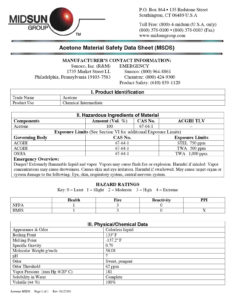As you build and maintain your airplane you will likely use a number of hazardous chemicals.
Knowing how to handle these chemicals safely and what to do in case of an accident can protect you from serious harm or even save your life. The bad news is that if you don’t you could be exposing yourself and others to serious harm. The good news is that it is fairly easy to get the information you need to be safe.
The key to being safe with hazardous chemicals is the Material Safety Data Sheet (MSDS). This is a form required by OSHA to be provided by the manufacturers and/or suppliers of all hazardous (and even those that aren’t) chemicals. Those of you with experience in manufacturing or construction are probably familiar with these, but those of you who work in other industries may not be. They contain pretty much all you need to know to safely handle various chemicals.
To get a MSDS all you need to do is search the chemical you are using with “msds” added to the search line. For example search for “acetone msds.” It is best if you also include the name of the manufacturer, but if you don’t know you can still get the information you need since many people make acetone, all of which is pretty much the same. If you are technology-adverse you can also ask for a MSDS from the vendor who sold you the chemical. They are required by law to provide it to you on request.

So, what is an MSDS going to tell you? Section 1 will start out with the name and manufacturer of the product. Next it will list the hazardous ingredients. Some products are mixtures of several chemicals, some of which are hazardous and others not. This section will tell you that right away. Then there are hazard ratings for health, fire, reactivity, and personal protection. These are quick number ratings to alert you to read farther in those categories. There is then more detailed data. Sections 6 through 8 are the critical items for your use, including health hazards, first aid procedures, and preventative measures including proper storage and handling.
Let’s go through these sections for our example of acetone. Section 6 says acetone may cause moderate to severe eye irritation. It may also be moderately irritating to the skin. High concentrations of acetone fumes can affect the central nervous system causing nausea, dizziness, paralysis, coma, and death. It is harmful and even potentially fatal if swallowed, and aspiration into the lungs can do severe damage to them. This is bad stuff!
Section 7 gives us first aid recommendations. For eye or skin contact flushing with water is a good treatment.
If inhaled fresh air, and if necessary, artificial respiration is recommended. If acetone is ingested it is important to not induce vomiting, since aspiration into the lungs may do serious damage. Dilute the chemical in the stomach with water or milk, and of course seek immediate medical attention.
Section 8 tells us how to protect yourself from harmful exposure. Good ventilation is important, but if concentrations in the air exceed safe limits a charcoal filter respirator may be needed. This does not mean you can use a cheap particle mask. They offer zero protection against the fumes of organic solvents like acetone. Goggles and gloves are also recommended. Finally, store acetone properly by keeping it in a cool place away from flames or ignition sources. Acetone is really flammable.
In a few minutes you can learn the essential things you need to know to keep you safe while using each chemical.
And it’s easy to do. When you are done reading about these products make a paper copies, put them in a notebook labeled MSDS, and keep it in your shop or hangar. If something does happen, you and any emergency responders can quickly determine the best way to treat any injury. This is required by law for your business, but it only makes good sense for you personally, too.



